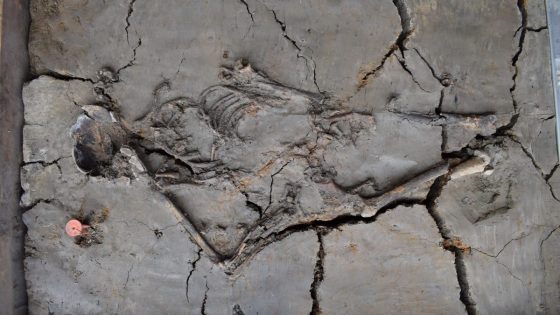Archaeologists find earliest baby’s grave in the Netherlands

Archaeologists working at a site in Nieuwegein have found what they say is the earliest example of a baby’s grave in the Netherlands.
The grave is some 6,000 years old and forms part of the so-called Swifterbant sites which date from the Stone Age and were home to communities of hunter-gatherers who lived along the banks of the river Vecht.
The baby is thought to be between newborn and six months old and was found resting in the crook of the arm of a young woman, probably its mother.
The clay layers of Nieuwegein have already yielded 136,000 well-preserved finds and is one of the most abundant Swifterbant sites in the Netherlands.
The presence of the baby only came to light when four skeletons which were dug up at the same time were analysed by archaeological consultancy RAAP in Leiden. What called the scientists’ attention was the fact that the right arm of the skeleton of a 20 to 30 year-old woman was crooked instead of straight, which would be the normal posture of Swifterbant bodies.
‘The posture of the woman’s body did not conform to what we had found so far, that is, bodies whose limbs are placed parallel to the body. We then made the moving discovery that she was in fact cradling a little baby,’ project leader Helle Molthof told broadcaster NOS.
Jaw
The bone fragments which revealed the presence of the baby included a tiny jaw with the milk teeth just emerging. This tells the archaeologists the baby may have been a couple of months old. It is very rare to find young children’s bones of this age because they perish very quickly but in this case a two meter thick layer of clay and peat preserved the fragments.
‘It really makes an impression when you find little baby teeth buried in clay for 6,000 years and see how similar they are to all those milk teeth that are kept in matchboxes by parents everywhere!’ NOS quotes Molthof as saying.
DNA
DNA testing will have to determine whether the woman is the baby’s mother, although there seems to be little doubt that she is, and the sex of the baby. The archaeologists hope the find will tell them more about the burial ceremonies of the Swifterbant people.
‘We know how they lived, what sort of food they ate, what their houses were like but we don’t know very much yet about how they buried their dead and what happened to the children,’ Molthof told the broadcaster.
Isotope analysis will have to show if the woman was born in the area or whether she travelled there at a later date.
Thank you for donating to DutchNews.nl.
We could not provide the Dutch News service, and keep it free of charge, without the generous support of our readers. Your donations allow us to report on issues you tell us matter, and provide you with a summary of the most important Dutch news each day.
Make a donation